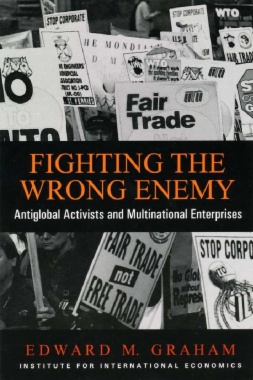Antiglobalist forces have been gaining greater momentum in recent years in their efforts to reverse what they view as the negative effects of an integrating global economy. Their influence was felt earlier when efforts to create a Multilateral Agreement on Investment (MAI) ended in failure in 1998 after France left the bargaining table at the Organization for Economic Cooperation and Development, effectively killing the initiative. In this book, through an evaluation of the MAI itself and the issues raised by its opponents, Edward M. Graham takes a fresh look at the growing backlash against globalization.
He first explores whether the MAI negotiations failed due to political maneuvering by antiglobalist nongovernmental organizations (supported by US organized labor) or because of irreconcilable differences among the negotiating parties over the substance of the issue of foreign direct investment. He then objectively and thoroughly assesses antiglobalist assertions that the activities of multinational firms have had negative effects on workers both in the home (investor) and host (recipient) nations, with a special focus on developing nations. An important finding is that multinational firms tend to pay workers in developing nations wages that are significantly above prevailing wages. Graham then examines the issue of globalized economic activity and the environment, finding that economic growth in developing nations can lead to increased environmental stress but also finding that foreign direct investment can lead to reductions in this stress. He finds that the worry of many environmentalists of a "race to the bottom" is not borne out by the evidence. The final chapters assess whether or not a negotiation to create a comprehensive agreement on investment should be included in a multilateral negotiating round at the World Trade Organization in the near future. The interests of developing nations in this agenda are given special attention. Graham indicates that, while many developing nations would accept such rules, it might nonetheless be premature to press for a comprehensive agreement at this time. Rather, a limited investment agenda might be both more feasible and more productive.
- Cover
- Contents
- Preface
- Acknowledgments
- Chapter 1 Introduction
- The Dog That Did Not Bark
- FDI and Its Benefits
- The MAI Negotiations Falter
- The Negotiations Fail
- An Economic Autopsy of the MAI
- Chapter 2 The MAI and the Politics of Failure: Who Killed the Dog?
- The MAI Is Conceived
- Deep Internal Difficulties Emerge
- The NGOs Enter the Stage
- The Cavalry That Did Not Arrive
- Chapter 3 Dissecting the MAI
- The Structure of the MAI
- Goals, Scope, and Application
- Obligations of Host Countries
- Investment Protection Provisions
- Dispute Settlement Procedures
- Exceptions, Safeguards, and Reservations
- The Mouse That Might Have Roared?
- Chapter 4 Globalization, Foreign Direct Investment, and Labor
- Direct Investment and Wages in Developing Countries
- Globalization and the Sweatshop Issue
- US Direct Investment Abroad and Employment in the United States
- Does Globalization Reduce Workers’ Bargaining Power?
- Summary and Conclusion
- Chapter 5 Globalization, Foreign Direct Investment, and the Environment
- The Environmental Impact of Globalization and Growth
- Foreign Investment: Can It Be Made Part of the Solution to the Environmental Problem?
- Toward Global Rules That Are Environmentally Friendly
- Conclusion
- Chapter 6 The MAI and the Developing Countries
- The Changing Position of Developing Countries on Foreign Direct Investment
- Changing Attitudes Toward Multilateral Rule Making
- Developing Countries and the Provisions of the MAI
- Is There a Deal Breaker?
- Is Any Negotiation on Investment Between Developing and Developed Countries Doomed to Failure? Doomed to Failure?
- Chapter 7 Where Does the Multilateral Investment Agenda Go From Here?
- Arguments For and Against Multilateral Investment Rules
- Is There a Constituency for Multilateral Investment Rules?
- Going for Less Than the Full Monty
- A Comprehensive WTO Investment Agreement: A Bridge Too Far?
- Appendix A Productivity and Wage Determination
- Appendix B Is Foreign Direct Investment a Complement to Trade?
- References
- Index

